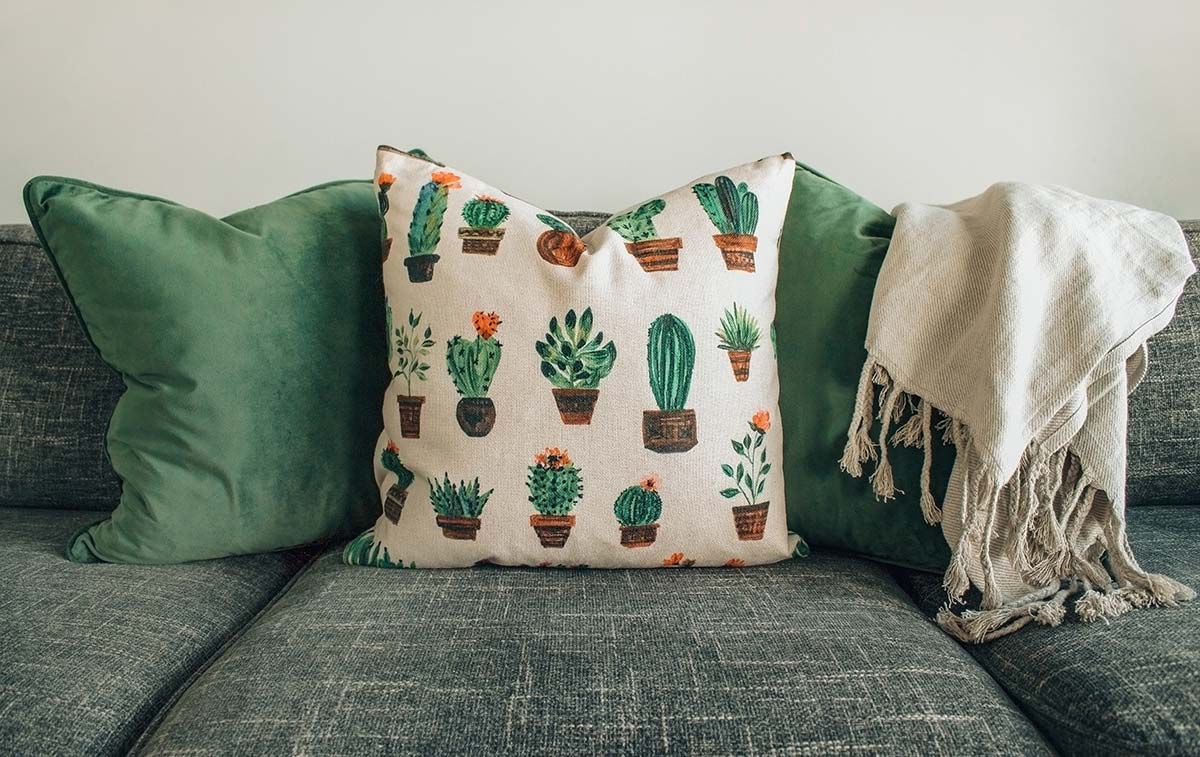Q.-What makes a good fabric for cushion and pillow covers?
A.-One that is both comfortable AND durable.
Here’s a comprehensive list of the most common choices:
1. Cotton
What to say about cotton that you don’t know already.
Cotton is a fluffy fiber that grows in a protective case around the seeds of the cotton plants.

That fiber is then spurned into a yarn and used to make the soft textile we all know and love.
This has been happening since antiquity. Particularly, since prehistoric times.
Humanity has always loved cotton for its many uses and properties: terrycloth (towels, robes), denim (jeans), and corduroy (trousers, jackets) are all cotton-based.
It can also be blended with other materials to produce rayon and synthetic fibers such as polyester, to name a couple.
Cotton is smooth and comfortable, breathable, stretchable, and easy to clean.
Whether blended or woven, cotton is an all-around great choice of textile for your cover.
My personal favorite blend is the linen-cotton blend. It gets the best of both worlds: organic, breathable, wrinkle-resistant, easy to wash, lightweight, and stronger than just cotton.
2. Linen
Light, ultra-breathable, and organic, linen is a textile made from the fibers of the flax plant.
Think of it as cotton’s fresher and more absorbent cousin. Like cotton, linen has been used by humanity from time immemorial in all sorts of products like clothing, towels, tablecloths, bed sheets, and covers.

Linen is a great choice of fabric for a bean bag because on top of being dry and cool, it’s a very strong and durable material.
So strong, in fact, that in classical antiquity it was used to make a type of body armor called “linothorax”; and in the Middle Ages it was used in shields, jackets, and bowstrings.
3. Twill
Twill is a type of woven fabric often used as sturdy work clothing and for durable upholstery.
Twill is a very easy-going textile, in the sense that, without compromising comfort, it’s wear-resistant and very easy to clean.
Another perk? Not only does it recover from creasing better than plain-weave fabrics do, but soiling and stains are less noticeable on its uneven surface than in other textiles.
With those characteristics, it won’t come as a surprise that twill fabrics are used a lot in toddler rooms and baby items.
Twills can be divided into even-sided and warp-faced. Even-sided twills include foulard, serge, and twill flannel; and warp-faced twills include chino, denim, and gabardine.
4. Denim
Denim is a warp-faced twill made of cotton. Because of that, it’s a perfect mix of both: utterly comfortable and extremely durable.

Also breathable, sturdy, and cool.
It will come as no surprise, but the denim industry worldwide is massive. The fabric is used extensively in clothes, accessories, vehicles, and furniture like bean bags and upholstery.
5. Suede
Suede is a type of leather with a napped finish made from the underside of the animal skin.
The term comes from the French “gants de Suède”, which literally means “gloves from Sweden”.
Due to its softness, it is very popular in accessories (such as handbags and gloves), shoes, and upholstery.
Suede is also very absorbent and pliable, but it has a few downsides: first of all, it’s not as durable as leather.
Moreover, due to its texture and open pores, it stains and gets dirty pretty easily.
In other words, suede is smooth and beautiful, but quite delicate.
Thankfully, there are a lot of non-animal alternatives, like ultrasuede, that resemble suede but are far more durable and resistant to liquid, stains, and crushing.
6. Microfibers
Microfibers are fine synthetic fibers with a diameter smaller than ten micrometers. This is even finer than the diameter of a strand of silk, which is itself about 1/5 the diameter of a human hair.
The most common types of microfibers are made from polyesters, polyamides, and polypropylene.
Microfiber fabrics are soft to the touch, lightweight, breathable, easy to clean, stain-proof, and wrinkle and wear-resistant.
Upholstery, apparel, knits, cleaning products… they can be used to make pretty much anything you can think about, even rope!

Downside? They tend to be flammable and emit toxic gases when burning.
Also, microfibers made from petrochemicals, like polyester or nylon, are not biodegradable.
 Did you know...
Did you know...







